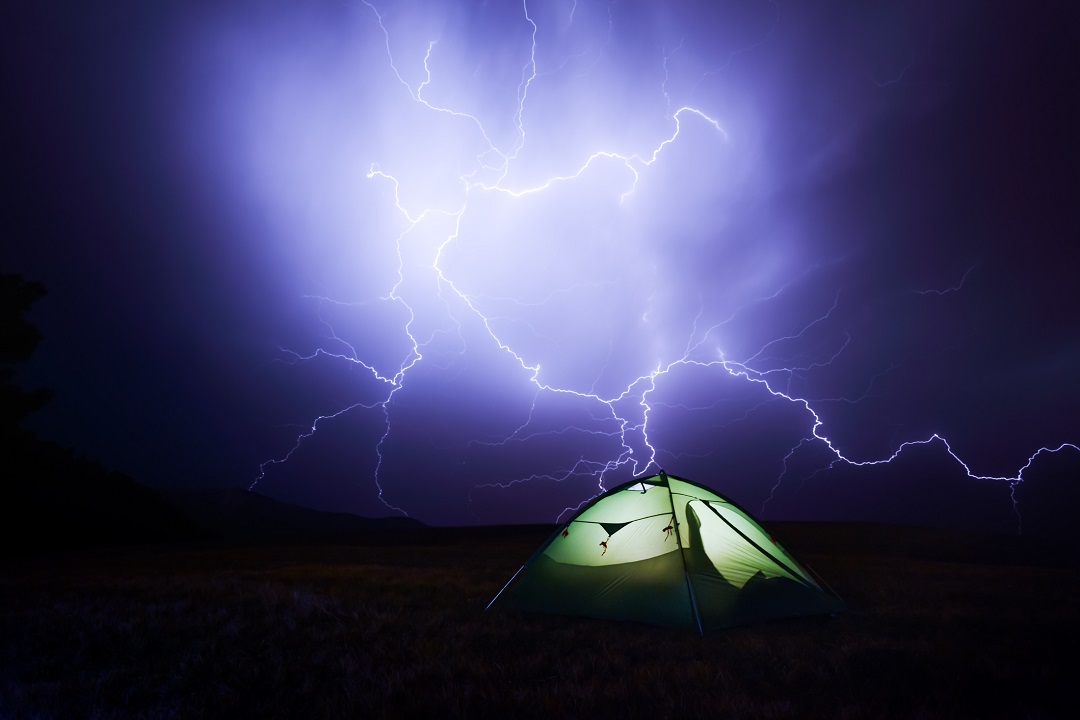The rain battered my tent. Lightning flashed overhead. The wind howled, bending my tent poles to alarming angles. It had hailed earlier in the day. As I lay there in the dark amidst the maelstrom, I wondered, “What do I do if it starts getting worse?”
I had a plan: “Grab your headlamp, pull on your rain jacket and boots, and run to the car.” Fortunately, the vehicle was only several feet from my tent. I knew I’d be safe inside until the storm relented.
Thankfully, it never came to that. The front blew through, and I drifted off to sleep. Still, I wondered, what would I have done if I weren’t near the car? What if I was in the backcountry when such violent conditions set in? What then?
Back to having a plan. When it comes to being outdoors and dealing with inclement weather, we should all adhere to the Boy Scouts’ motto: Be Prepared. Readiness goes a long way to surviving — simply checking the forecast beforehand and being familiar with seasonal weather patterns can help you prepare for the worst of what the elements may bring.
Here in the Midwest, major weather concerns boil down to five situations: flash floods, lightning, hail, high winds/tornados, and extreme heat. In an effort to help keep you prepared, we talked to Amy Shambarger and Paul Holle, wilderness EMTs and certified wilderness first-aid instructors from the National Outdoor Leadership School (NOLS) to get tips on how to read the weather and what to do when Mother Nature shows up in a foul mood.
Flash Floods. As their name implies, flash floods happen in an instant and can wash a campsite away in seconds. “It’s not about the weather and rain where you are, it’s about rain across the whole watershed,” Holle said. “Look at the forecast for all points along the route. A little rain across a wide area adds up quickly.” While there aren’t a lot of slot canyons in the Midwest, analyzing the geography of where you’re pitching your tent is important. The sandy bottoms near a stream or river might seem attractive for comfort, but pitching your tent in an elevated area and having an escape route to higher ground can help you survive.
Lightning. Rule of thumb: when thunder roars, get indoors. “If you hear thunder or see clouds building, act immediately,” said Shambarger. “Take shelter in a building or vehicle. Move to the safer terrain of rolling hills, forest, or simply get low.” Descend from elevated and exposed places and avoid cave entrances/overhangs. Stay away from solitary trees. Get off open bodies of water. Find the lowest ground possible (ditches, ravines, etc.) and assume the lightning position — feet together, on top of a foam pad/pack if possible, crouching to lessen the risk of ground current and side flashes. If you’re part of a group, spread out to reduce ground current channels.
Hail. “The main objective here is to seek shelter, whatever that entails,” Holle said. Hail is often accompanied by lightning; as being under a solitary tree or an overhang is not safe in lightning, a grove of trees can provide some level of protection and is a safer option. Assume the lightning position and protect your head and neck.
High Wind/Tornado. Intense thunderstorms can be accompanied by high winds or tornadoes. In these situations, it’s important to locate and secure your essential items: first-aid kit, fire ignitors, flashlight/headlamp, etc. Take down your tent, if possible, to prevent it from getting damaged. “If a sturdy building is not available, hunker down in a gully or other low spot. Crouch down and protect your head and neck until the storm has passed. Protect your eyes from flying debris,” Shambarger advised.
Extreme Heat. Reduce your activity levels during high heat periods. “Hydrate often and take frequent breaks. Plan to be outdoors early or late in the day to reduce exposure,” Shamabarger said. Dressing for the weather in light and loose clothing can also help. “This includes long sleeves and pants, as shorts and T-shirts can increase exposure,” said Holle. Stay in shaded areas as much as possible. If water is plentiful, dampen a cloth and drape it over your neck. Apply sunscreen liberally and often.
Perhaps most importantly, “Always maintain situational awareness,” Holle said. “If the forecast is amazing but then the weather isn’t, the weather isn’t wrong, the forecast is. One of the highest-risk attitudes is not being willing to change your plans according to current conditions. You must be willing and able to adapt to current weather. Otherwise, you’re asking for trouble.”
Author: Nick Tilley is a regular contributor to Terrain Magazine.


Leave A Comment